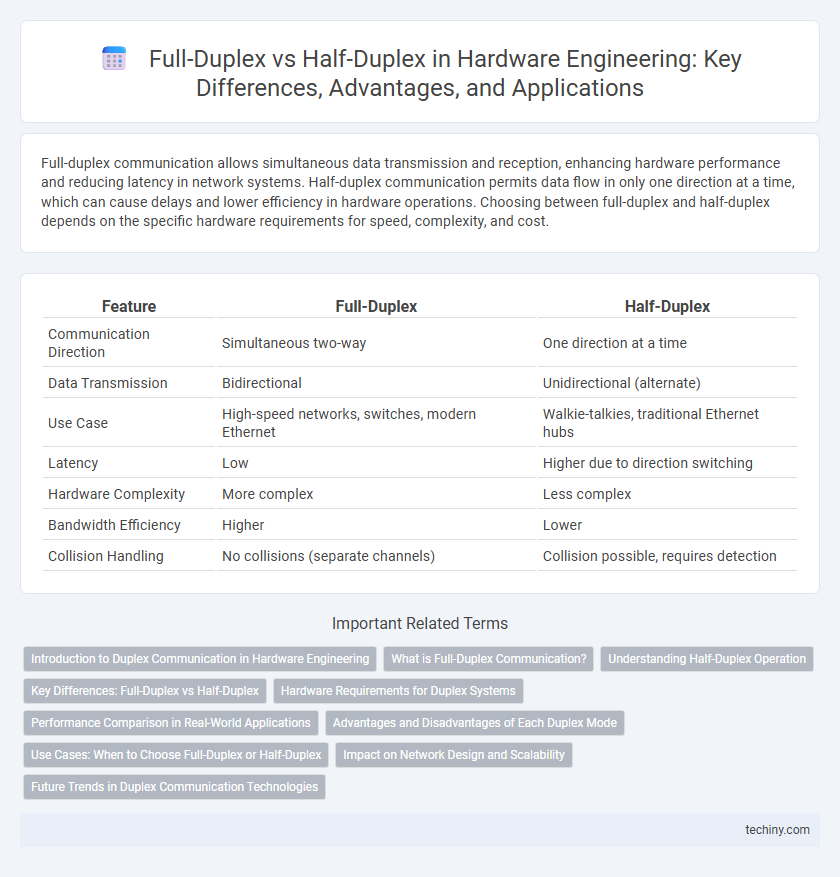Full-duplex communication allows simultaneous data transmission and reception, enhancing hardware performance and reducing latency in network systems. Half-duplex communication permits data flow in only one direction at a time, which can cause delays and lower efficiency in hardware operations. Choosing between full-duplex and half-duplex depends on the specific hardware requirements for speed, complexity, and cost.
Table of Comparison
| Feature | Full-Duplex | Half-Duplex |
|---|---|---|
| Communication Direction | Simultaneous two-way | One direction at a time |
| Data Transmission | Bidirectional | Unidirectional (alternate) |
| Use Case | High-speed networks, switches, modern Ethernet | Walkie-talkies, traditional Ethernet hubs |
| Latency | Low | Higher due to direction switching |
| Hardware Complexity | More complex | Less complex |
| Bandwidth Efficiency | Higher | Lower |
| Collision Handling | No collisions (separate channels) | Collision possible, requires detection |
Introduction to Duplex Communication in Hardware Engineering
Duplex communication in hardware engineering refers to the ability of a system to transmit and receive data between devices. Full-duplex systems enable simultaneous two-way data transfer, maximizing throughput and reducing latency in applications like network switches and telecommunication devices. Half-duplex systems allow data transmission in both directions but not at the same time, often used in radio communication and older Ethernet protocols to simplify hardware design and reduce costs.
What is Full-Duplex Communication?
Full-duplex communication allows simultaneous bidirectional data transmission between devices, effectively doubling the communication capacity compared to half-duplex systems. This mode is crucial in hardware engineering for optimizing performance in network interfaces, such as Ethernet and telephony systems, where continuous, two-way data exchange is essential. The implementation relies on separate channels or advanced multiplexing techniques to enable concurrent send and receive operations without collision.
Understanding Half-Duplex Operation
Half-duplex communication allows data transmission in both directions but not simultaneously, requiring devices to alternate between sending and receiving. This mode is common in hardware architectures that use a single communication channel to reduce wiring complexity and cost. Understanding half-duplex operation is crucial for optimizing hardware interfaces where bidirectional data flow is needed without full-time simultaneous transmission.
Key Differences: Full-Duplex vs Half-Duplex
Full-duplex communication enables simultaneous two-way data transmission, significantly increasing network efficiency and reducing latency in hardware systems. Half-duplex systems allow data flow in both directions but only one direction at a time, commonly used in simpler or legacy hardware designs. Key differences include bandwidth utilization, with full-duplex using separate channels for send and receive paths, whereas half-duplex shares the same channel, impacting throughput and collision management.
Hardware Requirements for Duplex Systems
Full-duplex systems require separate transmission and reception channels, often implemented with paired wires or separate frequency bands, demanding more complex hardware such as dual transceivers and advanced isolation components to prevent signal interference. Half-duplex systems utilize a single communication channel and switch between transmitting and receiving modes, reducing the need for duplicate hardware but requiring precise timing control to avoid collisions. The hardware complexity and cost increase significantly in full-duplex configurations due to the need for simultaneous bidirectional communication capabilities.
Performance Comparison in Real-World Applications
Full-duplex communication enables simultaneous data transmission and reception, doubling effective bandwidth and reducing latency compared to half-duplex systems, which only allow one direction at a time. In real-world hardware engineering applications such as network switches and communication interfaces, full-duplex designs significantly improve throughput and efficiency under high traffic conditions. Half-duplex remains viable for simpler or cost-sensitive implementations but often suffers from collisions and retransmission delays affecting overall system performance.
Advantages and Disadvantages of Each Duplex Mode
Full-duplex communication allows simultaneous two-way data transmission, improving efficiency and reducing latency, which is ideal for real-time applications like video conferencing but requires more complex hardware and higher bandwidth. Half-duplex communication permits data to flow in both directions but not at the same time, simplifying hardware design and reducing cost while potentially causing delays and collisions in high-traffic environments. Choosing between full-duplex and half-duplex modes depends on factors such as network design, application requirements, and cost considerations in hardware engineering.
Use Cases: When to Choose Full-Duplex or Half-Duplex
Full-duplex communication is ideal for applications requiring simultaneous two-way data transfer, such as video conferencing, VoIP calls, and high-speed network switches, maximizing throughput and reducing latency. Half-duplex is suitable for cost-sensitive or simpler systems like walkie-talkies, traditional Ethernet hubs, and industrial sensor networks where communication occurs in one direction at a time, conserving bandwidth and hardware resources. Selecting full-duplex or half-duplex hinges on the need for real-time interaction, bandwidth availability, and hardware complexity tolerances in hardware engineering projects.
Impact on Network Design and Scalability
Full-duplex communication allows simultaneous data transmission and reception, significantly enhancing network throughput and reducing latency, which supports scalable and high-performance hardware designs. Half-duplex systems, restricted to one-directional communication at a time, introduce delays and limit bandwidth efficiency, posing challenges for large-scale network expansion. Integrating full-duplex interfaces in hardware engineering improves network scalability by enabling parallel data flows and minimizing bottlenecks in complex systems.
Future Trends in Duplex Communication Technologies
Emerging duplex communication technologies emphasize full-duplex systems to enhance data throughput and reduce latency in hardware engineering. Advances in antenna design, signal processing algorithms, and interference cancellation techniques drive the shift toward simultaneous two-way communication. Future trends include integrating AI-driven adaptive duplex protocols and leveraging mmWave frequencies for ultra-high-speed, low-power hardware implementations.
Full-duplex vs Half-duplex Infographic

 techiny.com
techiny.com